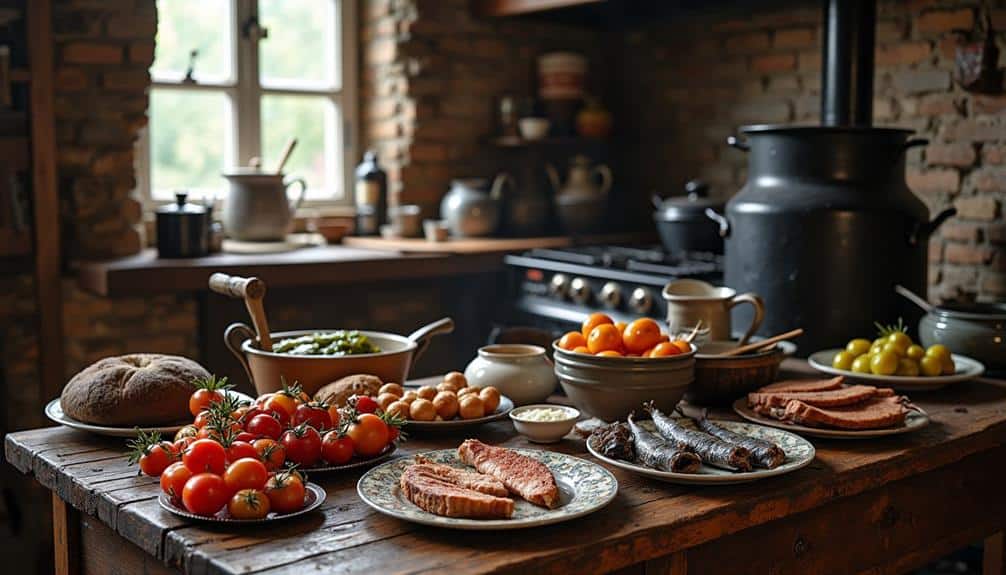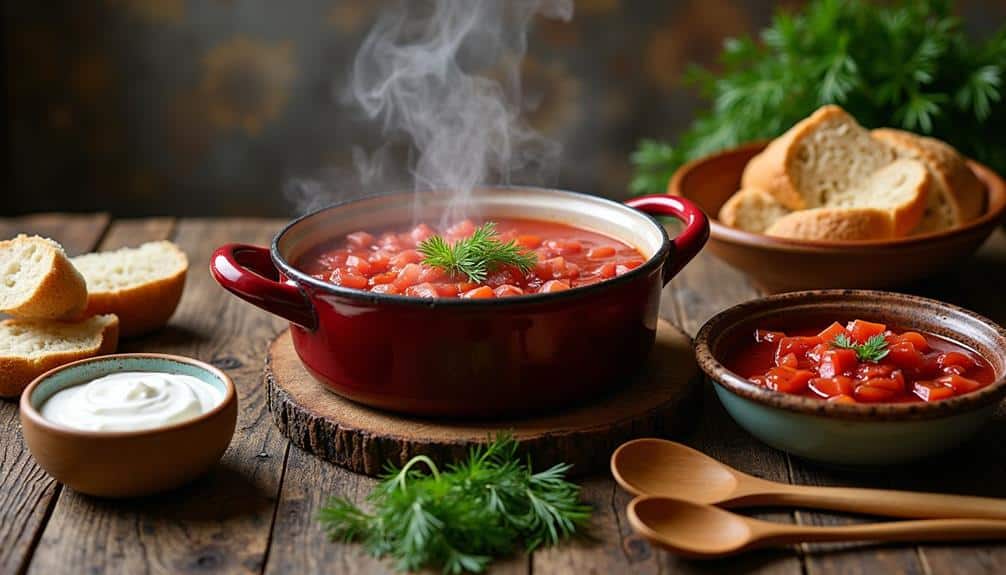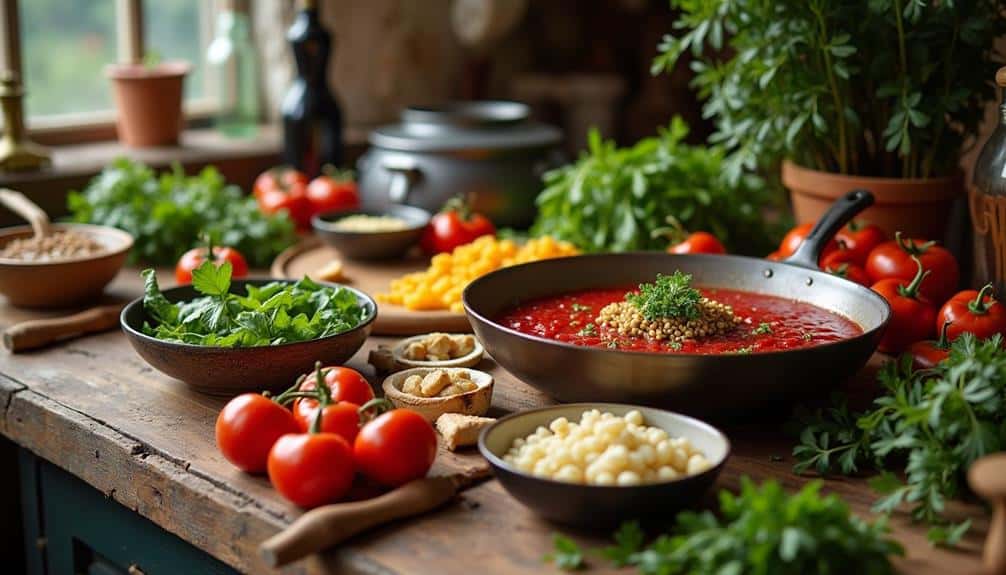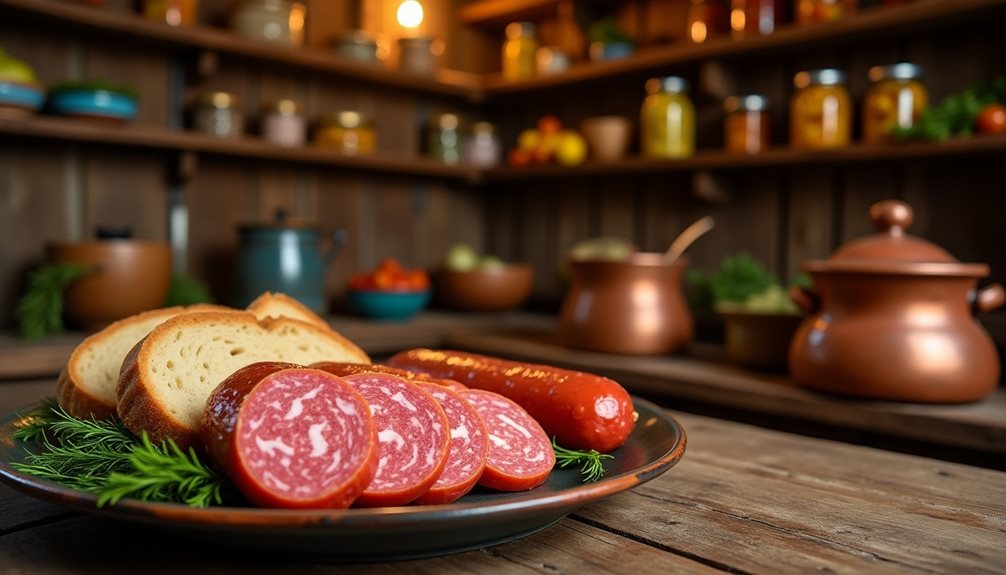Russia’s traditional diet is a fascinating amalgamation of regional diversity and historical influences, characterized by robust grains, root vegetables, and an array of seasonal produce. Staples such as rye, buckwheat, and potatoes form the backbone of many dishes, while soups like borscht and shchi are integral to the national cuisine. Dishes like pelmeni and beef Stroganoff highlight the rich culinary heritage that persists despite modern dietary trends and globalization. How do these traditional elements coexist with contemporary influences, and what unique flavors emerge from this intersection? The answer lies in the intricate tapestry of Russia’s culinary landscape.
Historical Influences

Historical influences have profoundly shaped the traditional diet in Russia, reflecting a confluence of cultural, geographical, and political factors. Russia’s vast expanse and diverse topography have led to significant regional variations in food practices, enriched by the cultural heritage of various ethnic groups. Historical migration patterns introduced new ingredients and culinary techniques, blending with indigenous customs to create a unique gastronomic tapestry.
Agricultural practices, deeply rooted in peasant traditions, have been essential in shaping the Russian diet. The reliance on hardy grains, root vegetables, and fermented foods stems from the country’s challenging climate and soil conditions. Trade routes, both ancient and modern, facilitated the introduction of spices and exotic ingredients, albeit limited by Russia’s relative isolation.
The Soviet influence further redefined food availability and consumption patterns. Centralized agricultural policies and rationing during times of scarcity led to a homogenization of diets, focusing on sustenance rather than diversity.
Religious significance also played an important role, with Orthodox Christian fasting periods influencing meal composition and timing, often emphasizing vegetarian and simple, rustic dishes.
In essence, Russia’s traditional diet is a reflection of its rich history, shaped by a myriad of cultural, geographical, and political influences, resulting in a diverse and robust culinary heritage.
Staple Ingredients
Central to the traditional Russian diet are staple ingredients that have sustained the population for centuries. Among these, grains such as rye and wheat play a pivotal role, particularly in the form of bread, which is a daily essential.
Buckwheat, often cooked as kasha, is another fundamental component, celebrated for its nutritional value and versatility. Potatoes, introduced in the 18th century, have become a cornerstone, used in a myriad of cooking techniques from boiling and frying to baking.
Vegetables like cabbage, beets, and carrots are integral, especially in pickled forms, which reflect the region’s adaptation to long, harsh winters. Dairy products, including sour cream (smetana) and cottage cheese (tvorog), are indispensable, adding richness and flavor to numerous dishes.
Regional variations further diversify these staples. In the northern regions, fish such as herring and salmon are more prominent due to proximity to the Arctic and Baltic seas.
Conversely, in the southern areas, closer to the Caucasus, one finds a greater emphasis on fruits, nuts, and spices. These regional differences underscore the adaptability and resourcefulness inherent in Russian cooking techniques, making the cuisine both diverse and deeply rooted in tradition.
Popular Soups

Popular soups are a cornerstone of Russian cuisine, offering both nourishment and comfort. Among these, borscht stands out as one of the most iconic. This beetroot-based soup, characterized by its vibrant red color, comes in numerous borscht variations, each reflecting regional nuances and family traditions.
While the classic version includes beets, cabbage, potatoes, and meat, alternative recipes may incorporate beans, apples, or even fish, showcasing the dish’s adaptability.
Another prominent soup is shchi, a cabbage soup that can be made with fresh or fermented cabbage, resulting in different flavor profiles. Traditionally, shchi is served hot and often garnished with a dollop of sour cream, which enhances its rich, tangy taste.
Soljanka, a hearty soup known for its complex flavor, combines an assortment of meats, pickled cucumbers, and olives. The addition of lemon slices and sour cream as soup garnishes further elevates its taste.
Ukha, a clear fish soup, is another staple, known for its simplicity and delicate flavor. Often seasoned with bay leaves and peppercorns, it is typically garnished with fresh herbs like dill or parsley, adding a revitalizing touch.
Traditional Main Dishes
How does one capture the essence of Russian culinary heritage if not through its traditional main dishes? Russia’s diverse landscape and climate have fostered a rich tapestry of regional variations, each contributing unique flavors and ingredients to the nation’s gastronomic repertoire.
Among these, Pelmeni, often referred to as Siberian dumplings, stand out. These delicate dumplings are typically filled with a mixture of minced meat, onions, and spices, and are served with sour cream or butter. The cooking technique involves boiling the dumplings until they float, ensuring a tender, flavorful bite.
Another emblematic dish is Beef Stroganoff, a classic hailing from the 19th century, which combines sautéed pieces of beef in a creamy mushroom and onion sauce. The dish’s simplicity and elegance make it a staple across various regions, each adding subtle twists through local ingredients or cooking techniques.
In the domain of hearty fare, Shashlik, a skewered and grilled meat dish, offers a glimpse into Russia’s multicultural influences. Originating from the Caucasus, this dish features marinated chunks of meat, meticulously grilled over open flames, resulting in a smoky, succulent delight.
Each of these traditional main dishes not only highlights regional variations but also underscores the rich culinary heritage of Russia.
Bread and Pastries

Bread and pastries hold an esteemed place in Russian culinary tradition, embodying both the daily sustenance and celebratory indulgence of the culture. Central to this tradition is rye bread, known as “cherny khleb”. This dense, dark bread made from various rye varieties, has been a staple in Russian households for centuries. Its hearty texture and rich flavor are well-suited to the harsh Russian winters, providing essential nutrition and warmth.
Pastries in Russia are not merely desserts but are deeply embedded in the cultural fabric. Techniques for creating these pastries have been refined over generations, resulting in an impressive array of baked goods.
Pirozhki, for instance, are small, stuffed buns that can be filled with a variety of ingredients, from meat to sweet fruit preserves. Blini, thin pancakes, often served with caviar or sour cream, showcase the versatility of Russian pastry techniques.
Additionally, traditional Russian pastries like kulich, a sweet bread enjoyed during Easter, highlight the intersection of culinary skill and cultural heritage.
These baked goods, whether for daily consumption or festive occasions, reflect the rich, diverse history of Russian cuisine, where each bite tells a story of tradition and community.
Seasonal Foods
The rhythm of Russian cuisine is deeply intertwined with the changing seasons, each bringing its own array of flavors and ingredients.
In spring, the thawing landscape yields an abundance of fresh greens, such as sorrel and nettles, which are often foraged and incorporated into soups and salads.
Summer ushers in a bounty of seasonal produce, including cucumbers, tomatoes, and berries like strawberries and raspberries, enriching the diet with vibrant, fresh options.
Autumn is a time of harvest, celebrated with an array of root vegetables like potatoes, carrots, and beets, as well as cabbages and pumpkins.
These ingredients are essential for hearty dishes that provide sustenance during the colder months. The foraging traditions continue with mushrooms and wild berries, which are collected from forests and preserved for winter consumption.
Winter, marked by its harsh climate, relies heavily on preserved and fermented foods.
Pickled vegetables, sauerkraut, and jams made from summer fruits become staples.
Potatoes and grains such as buckwheat and barley form the foundation of many meals, reflecting the necessity of storing energy-dense foods.
Consequently, Russian cuisine, guided by the seasons, showcases a profound connection to the natural world and its cycles.
Modern Adaptations

In contemporary Russia, the traditional diet has undergone significant transformations, influenced by globalization and technological advancements. These changes have introduced a variety of new ingredients and culinary techniques, reflecting broader cultural exchanges and urban influences.
Dietary shifts are evident as international cuisines and fast food establishments become increasingly prevalent in urban centers, altering traditional eating habits and preferences.
Health trends have also played a pivotal role in shaping modern adaptations of the Russian diet. There is a growing emphasis on balanced nutrition and organic produce, driven by the global movement towards healthier lifestyles. This shift is mirrored in the proliferation of health food stores and organic markets across Russia’s major cities.
Despite these changes, family traditions and regional variations continue to preserve the essence of Russian cuisine. Culinary innovations often merge traditional recipes with contemporary techniques, creating unique dishes that honor the past while embracing the present.
The results of globalization effects can be seen in the fusion of Russian staples with international flavors, making the modern Russian diet a rich tapestry of old and new. These adaptations illustrate a dynamic interplay between preserving cultural heritage and embracing contemporary influences.





